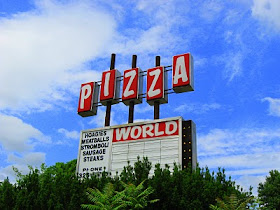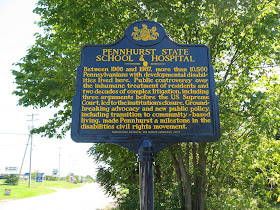
Perched high up on the Kittatinny Ridge of the Applachian Mountain sits a sanctuary for raptors and birds of prey.
Hawk Mountain provides the world’s first refuge for hawks, eagles, falcons and vultures. Offering 8 miles of trails and picturesque vistas, there is no shortage of nature to admire here. But things weren’t always so safe here for our feathered friends.
In 1929, the Pennsylvania Game Commission was paying hunters $5 for each goshawk they shot down. This was big money considering the Great Depression was upon us. The state believed the hawks were harming farmers’ livestock. In 1931, an amateur ornithologist from Philadelphia was visiting the area. What he found astounded and shocked him. Hundreds of hunters perched high in the mountain shooting the birds for their own pleasure. The dozens of carcasses lying on the mountain floor would become an inspiration to eradicate this horrible movement. Richard Pough, the young man from Philadelphia, tried to stop the hunters on his own, but was unsuccessful. Eventually photos he had taken of this travesty made their way into the hands of conversationalist Rosalie Edge.
Initially she leased 1,400 acres and hired a warden to keep the hunters off the property. By 1938 she had purchased and deeded the property to Hawk Mountain Sanctuary Association. Interestingly, the Hawk Mountain Sanctuary is not supported by the Pennsylvania or Federal Government, it is all privately run. Aside from the hundreds of raptors who migrate here every fall, there’s also a small pond where you’ll find frogs, turtles, fish and even newts. The sanctuary also has a native plant garden, consisting of over 250 species of Pennsylvania native plants.
It’s not only nature lovers who enjoy Hawk Mountain, Paranormal investigators are quite attracted to the place as well. The land was originally traced back to the Lenni Lenape Indian Tribe. Remains of a ceremonial ring have been found on the mountain, as well as Native American artifacts. It’s thought that this ceremonial ring could have been used for spiritual rituals. But this mountain has an even more horrid past than some ritualistic animal killings.
In the 1750’s, tensions between colonist and Native Americans began to escalate. On a cold February evening, a group of Indians slayed 5 family members relaxing in a family cabin. What the natives didn’t realize was that the family’s young son had survived the ordeal. Hiding in the nearby woods, the young man witnessed the brutal attack of his family. After many traumatic years, the son returned to the mountain and built a larger home, which he eventually sold to Mathias Schambacher and his wife. Sometime during the mid-1800’s, the couple opened the doors as a tavern and roadside inn. Slowly, overnight patrons from the inn began to steadily disappear. Everyone in the mountain area started to become suspicious of Mathias Schambacher, though not enough evidence was found to arrest the man.
In 1879 while on his death bed, Mathias had his wife contact a preacher for a death bed confession. Mr. Schambacher had admitted to killing between 11 and 14 men. He claims he lost count after his well become filled with human skulls. During his funeral, witnesses have attested to seeing lightning hit his grave. Maybe this accounts for the strange flashing lights many have witnessed on Hawk Mountain.
Many other visitors have sensed and seen what appears to be a 10-foot apparition that evil radiates from. Maybe this apparition haunted Mr. Schambacher as well, since he claims to have committed the murders due to a strange voice he would hear demanding him to kill. Perhaps undiagnosed schizophrenia is the reason. Whatever the reason, there is something mysterious going on here. Shortly after the purchase of Hawk Mountain, many of the staff felt a supernatural phenomenon immediately, and many human remains have been found in the area.
So whether enjoying nature is your thing, or if you prefer to live a little on the dark side, Hawk Mountain is a definite must visit.
 Not too far from the former home of Nellie Noll ( "the river witch" ) lies the Railroad House Inn. The establishment offers fine food, a bed and breakfast, and spirits. Originally built in the 1820’s, it had become a haven for all the men who worked along the river and many believe a few may still inhabit this historic establishment. Workers in the restaurant kitchen have witnessed cooking utensils being moved or strewn around on their own. A few have even seen the young blonde girl who causes all this commotion. She is dressed in Victorian garb, and seems to enjoy playing games with the kitchen staff. The spirits here don’t just inhabit the kitchen; they also pay visits to overnight guests. Those who have booked overnight visits to the Bed and Breakfast have felt numerous cold spots throughout the building and have seen a strange man sitting at the foot of their bed in the middle of the night. Others have encountered an elderly woman on a rocking chair, knitting the night away. Room 6 of the Bed and Breakfast may hold the most mystery. Even when the room is unoccupied, strange noises have been heard, and many have felt an overwhelming fear just nearing the room. But for the strongest spirits in the Railroad House, you need to visit the tavern, don’t just go looking on the shelves for the spirits.
Not too far from the former home of Nellie Noll ( "the river witch" ) lies the Railroad House Inn. The establishment offers fine food, a bed and breakfast, and spirits. Originally built in the 1820’s, it had become a haven for all the men who worked along the river and many believe a few may still inhabit this historic establishment. Workers in the restaurant kitchen have witnessed cooking utensils being moved or strewn around on their own. A few have even seen the young blonde girl who causes all this commotion. She is dressed in Victorian garb, and seems to enjoy playing games with the kitchen staff. The spirits here don’t just inhabit the kitchen; they also pay visits to overnight guests. Those who have booked overnight visits to the Bed and Breakfast have felt numerous cold spots throughout the building and have seen a strange man sitting at the foot of their bed in the middle of the night. Others have encountered an elderly woman on a rocking chair, knitting the night away. Room 6 of the Bed and Breakfast may hold the most mystery. Even when the room is unoccupied, strange noises have been heard, and many have felt an overwhelming fear just nearing the room. But for the strongest spirits in the Railroad House, you need to visit the tavern, don’t just go looking on the shelves for the spirits.






























